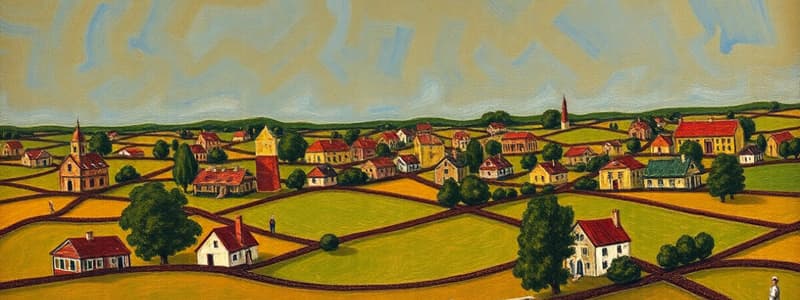Podcast
Questions and Answers
Which of the following was NOT a reason for migration to the colonies?
Which of the following was NOT a reason for migration to the colonies?
- Desire to join the military (correct)
- Access to abundant land
- Seeking better life opportunities
- Religion persecution
The Southern Colonies were primarily known for their rocky soil and harsh climate.
The Southern Colonies were primarily known for their rocky soil and harsh climate.
False (B)
Name one economic activity that was prominent in the New England Colonies.
Name one economic activity that was prominent in the New England Colonies.
Lumbering
The Middle Colonies were known for their _____ soil and diverse population.
The Middle Colonies were known for their _____ soil and diverse population.
Match the following colonies to their characteristics:
Match the following colonies to their characteristics:
Which group was notably more religiously tolerant than the Puritan colonies?
Which group was notably more religiously tolerant than the Puritan colonies?
Slavery and indentured servitude were prevalent in the Northern Colonies.
Slavery and indentured servitude were prevalent in the Northern Colonies.
Which cash crops were commonly grown in the Southern Colonies?
Which cash crops were commonly grown in the Southern Colonies?
The rocky soil and harsh climate of the New England Colonies made farming _____ difficult.
The rocky soil and harsh climate of the New England Colonies made farming _____ difficult.
Which colonies were included in the Southern Colonies?
Which colonies were included in the Southern Colonies?
Flashcards
Reason for Colonization?
Reason for Colonization?
Joining the military was not a reason for migration to the colonies.
Southern Colonies climate
Southern Colonies climate
The Southern Colonies were known for fertile soil and a warm climate, ideal for agriculture, not rocky soil and a harsh climate
New England Economy
New England Economy
Lumbering was a key economic activity due to the abundant forests.
Middle Colonies characteristics
Middle Colonies characteristics
Signup and view all the flashcards
Religious tolerance
Religious tolerance
Signup and view all the flashcards
Slavery in Northern Colonies
Slavery in Northern Colonies
Signup and view all the flashcards
Southern Cash Crops
Southern Cash Crops
Signup and view all the flashcards
New England Farming
New England Farming
Signup and view all the flashcards
Southern Colonies List
Southern Colonies List
Signup and view all the flashcards
Study Notes
13 Colonies
- English settlements grew on the East Coast of North America.
- European migrants, including English citizens, increased the population of these settlements and formed colonies.
- People migrated seeking:
- A better life than in Europe.
- Religious freedom to practice their beliefs without persecution.
- Wealth through land and labor opportunities.
- Slavery and indentured servitude: forced labor that led to many people being sent to the colonies involuntarily.
Colonial Regions
- 13 English colonies were grouped into three regions: New England, Middle, and Southern.
New England Colonies
- Massachusetts, Rhode Island, Connecticut, and New Hampshire.
- Rocky coastline, rolling hills, and large forested areas.
- Harsh climate with long winters and short summers, making farming difficult.
- Economy: focused on lumber, furs, whaling, fishing, and mineral mining.
- Religious: Puritan settlers seeking religious freedom.
Middle Colonies
- New York, Pennsylvania, New Jersey, and Delaware.
- Warm climate, fertile soil, flat land, navigable rivers, and wide valleys.
- Diverse population from England, Scotland, Ireland, the Netherlands, and German states.
- More religiously tolerant than New England, home to Quakers, Mennonites, and Lutherans.
- Economy: Major exporter of wheat and grains, also involved in mining, trading, lumbering, and shipbuilding.
Southern Colonies
- Maryland, Virginia, North Carolina, South Carolina, and Georgia.
- Warm climate, rich soil, and broad coastal plains.
- Economy: Agriculture-based with cash crops like tobacco, cotton, rice, and indigo grown on large plantations.
- Wealthy Europeans established plantations and relied heavily on slavery and indentured servitude.
Studying That Suits You
Use AI to generate personalized quizzes and flashcards to suit your learning preferences.




